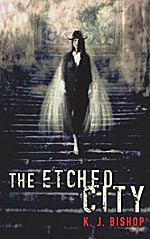
![]() Rhetori_Cat
Rhetori_Cat
7/3/2013
![]()
K. J. Bishop's first novel, The Etched City, appeared in 2003 and is her only novel to date. I had read a couple of her short stories, most notably "The Art of Dying" from the Vandermeer's The New Weird anthology, so I was somewhat prepared for Bishop's world of gunslingers and duelists, artists and prostitutes. At the same time, The Etched City is a novel that I can't get out of my head and that I have trouble explaining to others when I try.
The Plot: After years of fighting a military dictator, former compatriots Raule and Gwynn leave the desert for the exotic city of Ashamoil. There Raule is shunned from the school of doctors despite her extensive knowledge of field medicine and instead takes a post in a religious hospital in one of the poorest districts of the city. Gwynn takes work as a hired gun for a slave trader, to Raule's disgust. As Raule and Gwynn see each other more and more rarely, Gwynn begins an affair with a young artist named Beth, and at this point, the novel starts getting weird; Gwynn's work situation becomes increasingly unstable as his girlfriend's mental state appears to be deteriorating as well (at one point he goes to her house to find her with a bunch of strangers sewing together different parts of dead animals to create chimeric creatures). Beth eventually leaves the city, and shortly thereafter, Gwynn and Raule both decide to do the same, though separately.
In many ways, this novel felt less like a narrative and more like a series of very striking moments; Bishop's language was frequently visceral and vivid, but I had trouble seeing how things really fit together over time. I was even a little disappointed that we spent so little time with Raule when I found her much more interesting that Gwynn; once the two reach the city of Ashamoil, we become deeply embroiled in the goings-on of Gwynn and his employer, with occasional glimpses at what Raule is doing. One thing that I did really like, though, is the way that magic is introduced in the novel. I really like when magic isn't normally part of a world and the characters have to come to terms with extraordinary events just as readers do. Add in the fact that several characters are also alcoholics and drug users, and it makes it hard to tell when something extraordinary is actually happening and when it's only happening in the mind of a character. As such, the first few magical events are easily passed off as misperception or hallucination, but it slowly becomes clear that not all things are as they seem.
This unfolding of the magical world corresponds with one of the dominant themes of the novel, that of metamorphosis. A wide number of items and events in the novel are related to this theme: eggs, cocoons, fetuses, lobotomies, flowers, etc. Contrasted with this are moments of stasis, such as the poor of the city who have little to no mobility or the "primitive" people that Gwynn's employer holds in a never-ending civil war for the sake of his slave trade. The Rev seems to be a nexus for these themes in that he finds himself able to produce many kinds of small magic, but ultimately he is stuck with his own guilt and self-doubt and romantic fantasies about young, nubile women.
Since I read The Etched City for my SLA exam, I ended up thinking a lot about how the constructed contrast between urban and rural areas works in New Weird fiction. Much of the criticism on China Mieville's work concerns his construction of social spaces within urban environments, and after reading The Etched City, I'm increasingly interested in how urban and rural locations are related to issues of agency in these works.
http://www.speculativerhetoric.wordpress.com